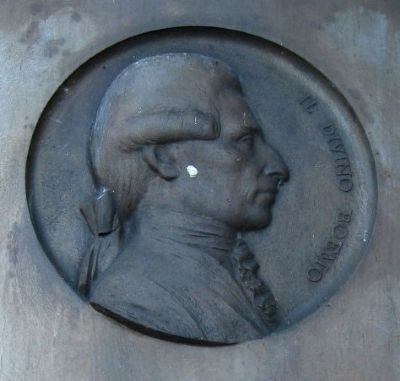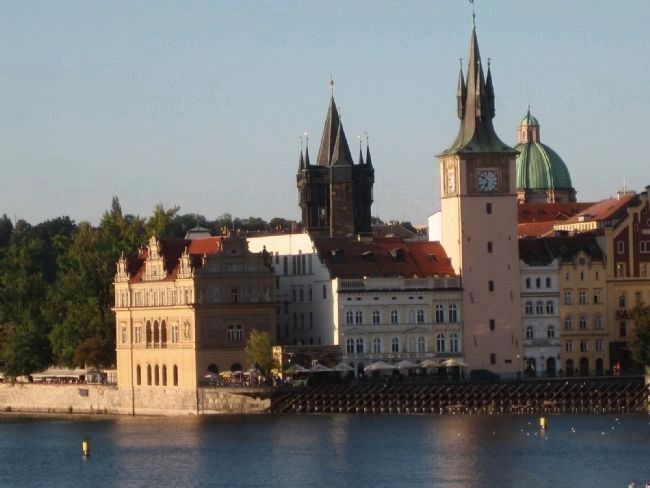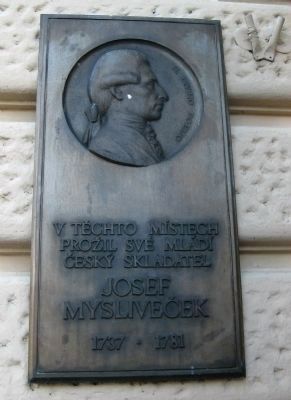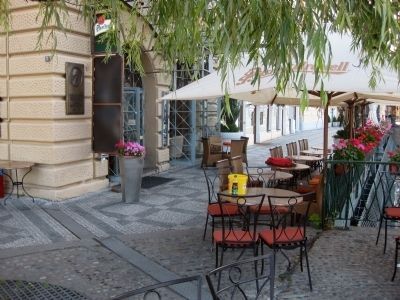Staré Mesto in Praha, Czech Republic — Capital City Region (Historical Capital of Bohemia)
Josef Mysliveček
Inscription.
{Marker text in Czech:}
prožil sve mladí
český skladatel
Josef
Mysliveček
1737 • 1781
{Marker text translated into English, more or less:}
At this location the Czech composer Josef Myslivecek spent his youth.
Topics. This historical marker is listed in this topic list: Arts, Letters, Music. A significant historical year for this entry is 1737.
Location. 50° 5.123′ N, 14° 24.782′ E. Marker is in Praha. It is in Staré Mesto. Marker can be reached from Novotného Lávka close to Smetanovo Nábř. Touch for map. Marker is at or near this postal address: Novotného Lávka 1, Praha 222 220, Czech Republic. Touch for directions.
Other nearby markers. At least 8 other markers are within walking distance of this marker. The Novotny Footbridge (within shouting distance of this marker); Church of St. Salvador (about 120 meters away, measured in a direct line); Johannes Kepler (about 150 meters away); Bohuslav Balbín (about 210 meters away); Francis Skaryna (approx. 0.3 kilometers away); Vojta Náprstek (approx. 0.3 kilometers away); Birthplace of Jaroslav Heyrovský (approx. 0.4 kilometers away); Franz Kafka (approx. half a kilometer away). Touch for a list and map of all markers in Praha.
Also see . . .
1. Wikipedia entry for Josef_Mysliveček (retrieved March 22, 2011) . Josef Mysliveček (March 9, 1737 – February 4, 1781) was a Czech composer who contributed to the formation of late eighteenth-century classicism in music. Mysliveček provided his younger friend Wolfgang Amadeus Mozart with significant compositional models in the genres of symphony, Italian serious opera, and violin concerto; both Wolfgang and his father Leopold Mozart considered him an intimate friend from the time of their first meetings in Bologna in 1770... (Submitted on March 23, 2011.)
2. Josef Mysliveček. Czechmusic.net's biography of Mysliveček:" The greatest Czech composer of 18th century. Son of a miller from Prague....He got the basic musical education at Jesuit College, later he studied mathematics, statics and hydraulics. In 1761 he became the flour-milling master but he did not take over father's mills; he rather abandoned them in favour of his brother, devoted himself fully to music..." (Submitted on March 23, 2011.)

Photographed By Andrew Ruppenstein, August 24, 2009
2. Josef Mysliveček Marker - detail
This closeup of the marker provides Mysliveček's profile. The wording on the right reads Il Divino Boehmo, Italian for "The Divine Bohemian". Mysliveček spent most of his professional life in northern Italy, writing operas.

Photographed By Andrew Ruppenstein, August 24, 2009
4. Josef Mysliveček Marker - much wider view, as seen looking north from the Legion Bridge
This is a view of the Novotného Lávka, or Novotny Footbridge, the former site of a number of mills on the Old Town side of the Vltava River in Prague. Josef Mysliveček's father was a miller, with the site of his mill being the left-most building visible here on the Footbridge. In the 1880s, that building was extensively remodeled and then housed a pumping station for the city water works. In 1936 that building then became the Bedrich Smetana Museum. The marker, if it could be seen here, would be where the lowermost right corner of the building meets the one story building next to it.
Credits. This page was last revised on February 10, 2022. It was originally submitted on March 22, 2011, by Andrew Ruppenstein of Lamorinda, California. This page has been viewed 828 times since then and 8 times this year. Photos: 1. submitted on March 22, 2011, by Andrew Ruppenstein of Lamorinda, California. 2, 3, 4. submitted on March 23, 2011, by Andrew Ruppenstein of Lamorinda, California. • Syd Whittle was the editor who published this page.

